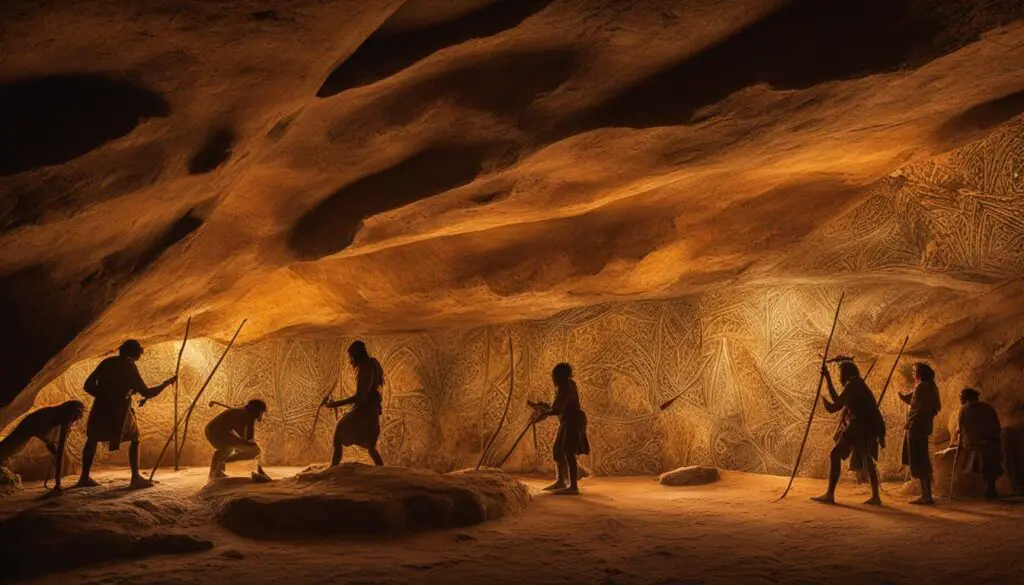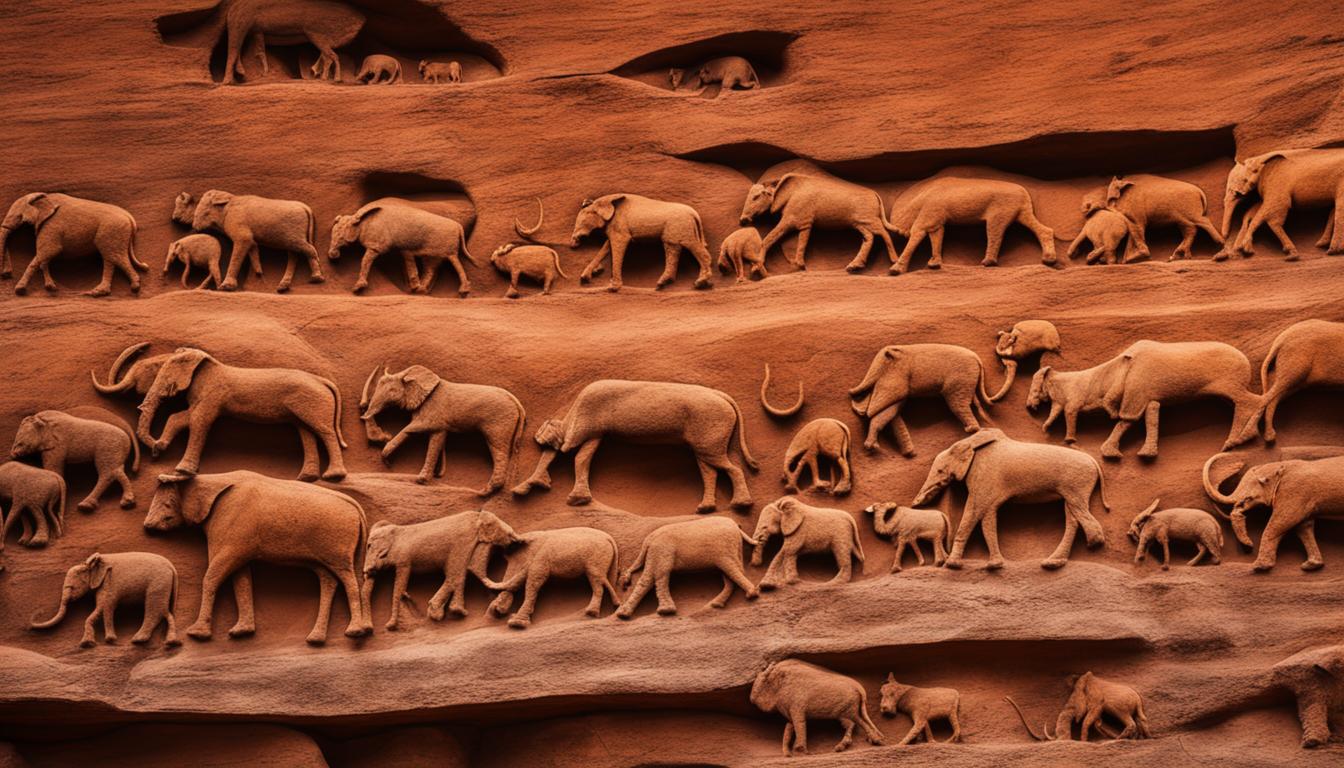The Stone Age is a fascinating period in ancient Indian history that represents a time before the invention of writing and development. It spans five distinct periods – Paleolithic, Mesolithic, Neolithic, Chalcolithic, and Iron Age – each with its own unique characteristics and advancements. During this prehistoric era, the lives of Stone Age people in India were shaped by their ability to adapt to a changing environment and develop innovative tools for survival.
Throughout the Stone Age, ancient Indian history evolved in remarkable ways, transitioning from a hunter-gatherer culture to settled agricultural communities. This shift marked a significant milestone in human civilization, paving the way for advancements in technology, trade, and social organization.
Key Takeaways:
- The Stone Age represents the prehistoric period in India, characterized by the absence of writing and development.
- Ancient Indian history is divided into the Paleolithic, Mesolithic, Neolithic, Chalcolithic, and Iron Age.
- Stone Age people in India used rough and heavy tools made of stone, wood, and bone during the Paleolithic Age.
- Bhimbetka caves in India showcase one of the oldest examples of prehistoric art.
- The preservation of the Bhimbetka paintings provides insights into the lives and artistic expressions of Stone Age people in India.
The Artistic Legacy of Stone Age People in India
The Bhimbetka caves near Bhopal, Madhya Pradesh, hold a treasure trove of ancient art that dates back thousands of years. These rock shelters, nestled within quartzite formations, offer a unique glimpse into the artistic legacy of Stone Age people in India.
The Bhimbetka caves are home to over 750 rock shelters, with 15 of them open to visitors. Within these caves, ancient artists adorned the walls with stunning paintings that spanned many centuries, with the oldest dating back to the Upper Paleolithic era. These prehistoric paintings, known as petroglyphs and pictographs, depict a rich tapestry of life in ancient times.
Step within the Bhimbetka caves, and you’ll be greeted by a vibrant gallery of images. The walls showcase detailed depictions of animals such as deer, antelopes, elephants, and birds, capturing the diverse wildlife that once roamed the land. Stick-like human figures engage in various activities, shedding light on the lives of the Stone Age people.
These ancient paintings offer a glimpse into the daily activities and rituals of Stone Age communities. From hunting and gathering to celebrations and burial ceremonies, the art preserves the essence of their lives and cultural practices.
One of the remarkable aspects of these ancient artworks is the evolution they depict. As you explore the caves, you’ll witness the transition from a nomadic hunter-gatherer lifestyle to settled agricultural communities. These paintings provide a visual narrative of the progress made by ancient societies in India, showcasing their shift from a solely subsistence-based existence to a more settled and organized way of life.
The Techniques of Stone Age Artists
The artists who created these masterpieces used basic tools and natural pigments sourced from their surroundings. Brushes made from twigs were employed to apply paints made from local minerals and organic elements. The predominant colors used in the paintings are red and white, with occasional splashes of green and ochre, which lend vibrancy to the ancient artwork.

Bhimbetka’s significance as a cultural site cannot be overstated. It has been recognized as a UNESCO World Heritage site, lauded for its exceptional preservation of prehistoric paintings. These artistic wonders offer valuable insights into the cognitive and cultural development of early humans, with evidence pointing to their use as early as 100,000 BC.
Visiting the Bhimbetka caves is like stepping back in time, walking in the footsteps of our Stone Age ancestors. The ancient art found within these rock shelters continues to captivate and inspire, allowing us to appreciate the artistic legacy of those who came before us.
The Fascinating World of Stone Age People in Bhimbetka
The Bhimbetka caves in India offer a captivating journey into the lives of Stone Age people and the incredible artworks they created. These caves were discovered in 1957 by renowned archaeologist Vishnu Wakankar, who noticed the striking resemblance of the landscape to rock shelters in France. Since then, extensive excavations have revealed more than 10 layers of paintings on the cave walls, providing a wealth of archaeological discoveries.
These ancient artworks offer valuable insights into the daily lives of Stone Age communities. The paintings portray scenes of hunting, farming, and communal activities, showcasing the rich tapestry of ancient life. But what truly sets Bhimbetka apart is the incredible preservation of these paintings. The rock overhangs and natural shelter of the caves have protected these masterpieces from the elements for thousands of years, allowing us to marvel at the artistic talents of our ancestors.
As you explore the Bhimbetka caves, you’ll also encounter nature’s wonders in the form of spectacular rock formations. Some of these rocks bear uncanny resemblances to animals and mythical creatures, adding an enchanting touch to the ancient site. Walking through the caves, you can’t help but imagine the skill and dedication of the Stone Age artists who brought these paintings to life. With basic tools and natural pigments, they created intricate details that continue to inspire and awe visitors today.
Bhimbetka is a true testament to the artistic legacy and the way of life of Stone Age people. It transports us back in time, offering an extraordinary glimpse into their world of wonder and beauty. Discover the archaeological treasures, admire the rock formations, and immerse yourself in the preservation of ancient art at this remarkable site.
FAQ
What is the Stone Age?
The Stone Age refers to the prehistoric period in India when there was no writing and development. It consists of five periods – Paleolithic, Mesolithic, Neolithic, Chalcolithic, and Iron Age.
What are the periods in ancient Indian history?
The periods in ancient Indian history are Paleolithic, Mesolithic, Neolithic, Chalcolithic, and Iron Age.
What is the difference between pre-history, proto-history, and history?
Pre-history refers to events that occurred before the invention of writing. Proto-history is the period between pre-history and history, during which a culture or organization had not yet developed but is mentioned in the written records of a contemporary literate civilization. History is the study of the past after the invention of writing and the study of literate societies based on written records and archaeological sources.
What are the sources used to reconstruct ancient Indian history?
The reconstruction of ancient Indian history is aided by non-literary and literary sources. Non-literary sources include coins, archaeology/material remains, inscriptions/prashastis, and foreign accounts. Literary sources include religious literature and secular literature.
What defines the Paleolithic Age?
The Paleolithic Age is characterized by rough and heavy tools made of stone, wood, and bone.
What defines the Mesolithic Age?
The Mesolithic Age is marked by the use of microliths and a transition from a hunter-gatherer culture to a settled agricultural lifestyle.
What defines the Neolithic Age?
The Neolithic Age is defined by polished or ground stone tools and the cultivation of land.
What are the Bhimbetka caves?
The Bhimbetka caves near Bhopal, Madhya Pradesh, are home to one of the oldest examples of prehistoric art in India. These quartzite rock formations contain over 750 rock shelters, with 15 of them being accessible to tourists.
What can be found in the Bhimbetka caves?
The Bhimbetka caves contain paintings that span many centuries, depicting animals, stick-like human figures, and various activities of Stone Age people such as hunting, gathering, dancing, and burial ceremonies.
How were the paintings in the Bhimbetka caves created?
The ancient artists used basic tools such as rough brushes made from twigs and paints made from local minerals and organic elements.
What is the significance of Bhimbetka?
Bhimbetka is a UNESCO World Heritage site and is considered the earliest cradle of cognitive human evolution, with evidence of its use dating back to 100,000 BC.
Who discovered the Bhimbetka caves?
The Bhimbetka caves were discovered by archaeologist Vishnu Wakankar in 1957, who noticed the impressive landscape resembling rock shelters in France.
What can visitors see in the Bhimbetka caves?
Visitors can explore the caves and marvel at the intricate details of the paintings, imagining how the ancient artists created them using basic tools and natural pigments.

